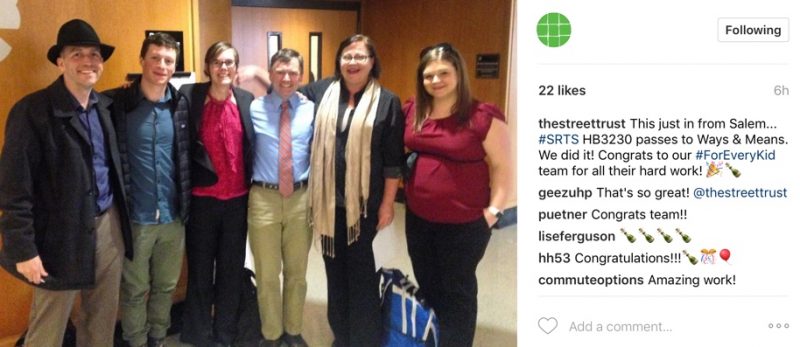
The Street Trust celebrated a legislative victory this morning as the House Committee on Transportation Policy voted 8-1 in favor of House Bill 3230.
The bill, sponsored by House Representative John Lively (D-Springfield) and Senator Kathleen Taylor (D-Milwaukie), would take $12 million from the state’s General Fund and deposit it into a Safe Routes to Schools Fund that would be administered by the Oregon Department of Transportation and mandate that ODOT spends at least $20 million of their State Highway Fund allotment on the safe routes infrastructure projects. It would also prioritize the funding toward low-income Title I schools and require infrastructure projects to be coupled with educational and outreach components.
“We can pave roads and build highways, but that doesn’t really make a place. That doesn’t make a community.”
— Kim Curley, Commute Options
As we shared earlier this month HB 3230 is a major priority for The Street Trust and the For Every Kid Coalition — a group of over 100 organizations working to increase Safe Routes to School program funding.
At today’s committee meeting in Salem, Street Trust Campaign Director LeeAnne Fergason testified to lawmakers that the state needs to put money on the table not just for more crosswalks and bikeways near schools — but for the marketing programs to promote them. “We know infrastructure alone can increase walking and biking by 20 to 25 percent, but combined with education and encouragement programs we see 40 to 45 percent of kids walking and biking.”
Kim Curley, who works with Commute Options in Bend, also testified. She said transportation funding must mean more than status quo road projects. “We can pave roads and build highways,” she said, “But that doesn’t really make a place. That doesn’t make a community.” And she echoed the importance of coupling infrastructure spending with education and outreach. “If you build it, they will not come unless they know about it.”
Advertisement
According to Curley and Fergason, ODOT currently spends only dedicates $500,000 to safe routes-specific projects, or enough to reach just 20 per cent of Oregon’s schools. “We’re spreading the peanut butter very, very thin,” Curley said.
“If we don’t have safe bike pathways and places to walk to school… there are a lot of other expenses the state will be paying for.”
— Representative Susan McLain (D-Hillsboro)
After hearing testimony, committee Chair Caddy McKeown (D-Coos Bay) reminded everyone that legislators are also working on a transportation funding package that includes $15 million a year* for Safe Routes to School projects — which they say is enough funding to “complete the safe routes within a quarter-mile of all elementary and middle schools in Oregon in 10 years.” (*Would require a 40 percent local match.)
Only one committee member voted against HB 3230. Rep. Greg Barreto, a Republican who represents eastern Oregon, said, “This is a hard one. There are a lot of wonderful things; but those wonderful things have to be paid for. With the situation the state is in right now with the spending issue, I struggle with voting for more good things… I think these are good and admirable and even needed things, but it’s just a tough time.”
Rep. Susan McLain, a Democrat from Hillsboro said she’d vote yes because, “If we don’t have safe bike pathways and places to walk to school… there are a lot of other expenses the state will be paying for.”
In an interesting twist, Rep. Rich Vial, the Washington County Republican who pushed for a bill that would allow cities to form tolling districts to build new highways, made the motion to move HB 3230 to the Ways and Means Committee. A few hours later he shared via his constituent newsletter that his highway bill is dead.
HB 3230 will now move to the Ways and Means Committee. Rep. McKeown would rather pass Safe Routes funding as part of the larger, comprehensive effort. But she said she wanted this bill to sit in Ways and Means, “To act as a backup, just in case – God forbid – we aren’t successful with our transportation package.”
— Jonathan Maus: (503) 706-8804, @jonathan_maus on Twitter and jonathan@bikeportland.org
BikePortland is supported by the community (that means you!). Please become a subscriber or make a donation today.


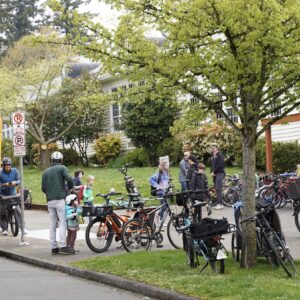
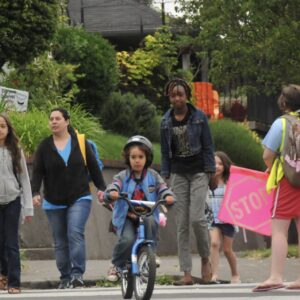
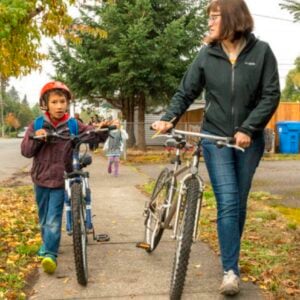
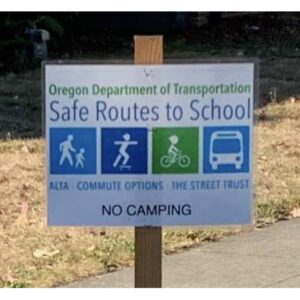
Thanks for reading.
BikePortland has served this community with independent community journalism since 2005. We rely on subscriptions from readers like you to survive. Your financial support is vital in keeping this valuable resource alive and well.
Please subscribe today to strengthen and expand our work.
“If you build it, they will not come unless they know about it.” This is silly. Commute Options has been a huge waste of time in Bend with their outreach and education but no progress on infrastructure. Mode share in Bend hasn’t budged in 15 years. If we had spent the money the city allocates to them on infrastructure over the last 15 years, those paths and lanes would be full. People want safe routes. No amount of outreach makes up for infrastructure.
Build it and they will come. They will not know about it if you do not build it.
If you build it, they’ll camp on it.
Instead of criticizing Rep. Barreto, let’s ask him what his plan is for $20M worth of highway funds and why it’s better than making schools a safe destination for kids. Surely he’s got one…
I’ll go on a limb and guess it has everything to do with how their roads, houses, and schools are laid out.
A quarter mile is absolutely worthless and would probably have no impact on safety. May as well throw in a 15mph limit on open rural roads while we’re at it.
Decades ago, a lot more kids walked and biked and somehow it wasn’t regarded as so unsafe. The infrastructure didn’t get worse during the intervening period.
Agreed. One of the stupidest bike lanes in history exists in my neighborhood. Exactly one block in front of Cezar Chavez school on Willis. A total waste of paint.
It was installed to remove space from the perceived travel lane. PBOT regularly requires developers to build floating pieces of sidewalk without connection to anything else. Your complaint sounds like a variation on the ‘all or nothing’ argument.
Willis is also a City Bikeway, so policy encourages adding bike facilities when possible.
Except PBOT has recently changed this policy for sidewalks (at least on streets that don’t have already defined curbs). LTIC makes a lot of sense and will allow us to pool development money and put in full blocks of sidewalks instead of orphaned, one property sidewalks that are fairly useless.
“Decades ago, a lot more kids walked and biked and somehow it wasn’t regarded as so unsafe. The infrastructure didn’t get worse during the intervening period.”-Kyle Banerjee
Oh, you mean back when we had cops enforcing traffic laws and violating those laws was a criminal offense, not just an infraction?
In fairness, a much higher percentage of the population was children back in the ’70s, there were fewer cars per adult and people didn’t drive as many miles, so there was a bit of safety in numbers going on.
People didn’t drive nearly as many miles, but it was much less safe back then.
What’s different is that over the years, hуsteriа has built up surrounding process of getting to/from school. My bros all complain about being *required* to drop off kids and personally accompany them. Before I moved to PDX, I used to make fun of parents who’d drive to the end of their driveways to wait with their kids for the bus until I found out they had to wait with the kids. In PDX, I’ve gotten stuck behind school buses that stop at multiple adjacent houses because it’s apparently too dangerous to walk 50 feet.
The other thing that’s different is the number of people who think of safety in terms of specific facilities in very limited areas rather than using judgment. With regards to Barreto, distances are much greater in rural areas than the city. In his district, there are likely few if any kids living within quarter mile of the schools in his area so requiring specific infrastructure like this is expensive, silly, and doesn’t do bupkus for safety. Likewise, if you’re in a big flat area with awesome visibility, a 20mph limit is equally gооfy.
Safety in numbers doesn’t work with peds the way it does with bikes. As a ped, you simply don’t walk in the traffic lane when there are cars there.
It was less safe for drivers, but we don’t really have enough data to show that it was less safe for pedestrians. The decrease in pedestrian deaths over the past few decades can mostly be attributed to an overall reduction in walking. We have recently seen a significant increase over the past few years in pedestrian deaths. The problem is that our focus on “highway safety” is all on crash survivability, which only helps the occupants in the vehicles. We have done very little to improve the built environment to reduce pedestrian hazards.
It was a *lot* less safe for peds and cyclists. Speeding drivers have always been around and infrastructure was nonexistent — in the 70’s, speeding was celebrated as part of the backlash to the 55 limit. Parents driving kids to school was extraordinarily rare where I lived (I can’t remember any who got a ride on a daily basis), though a significant minority of kids managed to get cars in high school.
In my own case, I lived 7 miles from school. I cycled from the time I was 13 onwards because it was twice as fast as the bus. Most of my friends lived miles from school and none lived within a quarter mile. Many of them rode bikes. In town speed limits were 30 on residential and I seriously doubt there are bike lanes to this day. Most of my commute was on rural highway and on roads too narrow to have a stripe but which locals routinely barreled down the center at 50.
Parents and teachers drilled how dangerous it was into our heads and while kids don’t have the same ability to perceive as adults, they’re a lot smarter than we give them credit for. Also, it’s not like drivers don’t care even if they make poor choices (and always did). Drunk driving wasn’t even taken seriously until sometime in the 80’s. People used to just accept it or even think of it as funny — you’ll see this reflected in old movies.
It is extremely dangerous to assume people will do what they’re supposed to — especially where yields are concerned. While the rules of the road tell you what should happen, you still need to be ready for when people make mistakes.
The reason it seems so dangerous out there is that too many people don’t respect what they’re up against and refuse to modify their behavior because they think that others should change first. Improving infrastructure in a few tiny areas helps but it’s easy to exaggerate the impact because the problem is everywhere.
“As a ped, you simply don’t walk in the traffic lane when there are cars there.”
For kids trying to walk to school, there is a lot more to it than that. The biggest challenges the kids in our neighborhood face are speeding drivers (kids do not have the same ability to judge the speed of oncoming traffic that we do: https://consumer.healthday.com/cognitive-health-information-26/brain-health-news-80/kids-can-t-accurately-judge-speed-of-approaching-cars-study-646577.html), drivers failing to yield when turning right (this is a CONSTANT problem at the Bethany-Oak Hills intersection, and the crossing guards have to literally walk out into the road to shield the kids), drivers failing to yield the right of way to allow kids to cross at unmarked intersections, drivers BEHIND a yielding driver going around the driver who has yielded, visibility problems in inclement weather, and a walking path to school that is too skinny for the number of users and is regularly underwater, which has resulted in bike/scooter crashes.
Most of these problems are exacerbated by parents unwilling to let their kids walk to school under these conditions, but even if all of the parents stopped driving their kids to school tomorrow we would still have other issues to deal with.
And instead of dismissing Rep. Barreto as a small town legislator, we should recognize that House District 58 also includes Pendleton and LaGrande.
The state is facing a $2 billion deficit. Personally, I think that the $12 million this bill would take from the General Fund should be off-set by cuts elsewhere or new revenue. We should have that conversation.
These two large cities have 17,000 and 13,000 residents respectively and schools that don’t exactly have treacherous approaches.
The pressure to protect the kids with this measure must be intense.
Just sayin that calling Rep. Greg Barreto, “…a Republican who represents a small rural town in eastern Oregon” isn’t entirely accurate.
thanks rainbike! That’s a big error on my part. no harm meant. i will correct the post ASAP.
Cool. Thanks.
“…Personally, I think that the $12 million this bill would take from the General Fund should be off-set by cuts elsewhere or new revenue. …” rainbike
okay…cuts from what or where? What new revenue?
Towns with populations of 17,000 and 13,000 residents, don’t seem particularly large to me, particularly as compared to big cities here in the Willamette Valley. Big for that part of the state, but otherwise kind of small towns. I never hear that residents east of the Cascades have high incomes. The urban rural divide is an ongoing issue, in addition to the east side of the state being comparatively more conservative.
Those are some things that may partly explain Barreto’s feelings about the bill. Additionally, he may have had in mind, enhancing his image among fiscally conservative constituents in his district, taking some comfort in the fact that he could vote against the bill, and it would still pass without a problem.
While I, recognize the importance many people have in having fast and efficient road networks for driving available to them, streets surrounding schools in neighborhoods seem particularly vulnerable to excessive driving tendencies…and even in small towns, or towns comparatively small to metro area towns, improvement in safety of routes to schools for walking may be timely investments.
Not being an elected official or staffer, I’m not certain that it’s my job to identify exactly where budgetary cuts or revenue increases should be made in order to support this bill. That doesn’t delegitimize my preference for a revenue-neutral solution. You may think that sounds like a cop-out, but I’ve hired my reps in the state legislature to figure out how to make that work. The average citizen, as I consider myself, has no idea about the complexities.
I agree with the intent of the bill – safe routes to school – but passage without addressing the issues above would not be “without problem”. This state has a spending problem. We can’t offer all the wonderful things we want to offer, things that people across the state deserve, without off-setting expenditures elsewhere or increasing revenues. I mean, we can, but the deficit spending habit will come back to bite us some day.
So, I turn this back on you. Are you okay with continued deficit spending? How do you justify this? Would you recommend specific cuts or increased revenue streams? Or, would your answer be similar to mine: I have ideological preferences, but it’s our elected officials’ job to figure out the details.
If you build it and it becomes controversial and ends up as an issue on the news, then they’ll both have it and know about it.
One question: What is The Street Trust?
The Street Trust (formerly the BTA) – http://thestreettrust.org/
Guess who is big in education and outreach? Yup. Forget it and spend the money on infrastructure.
The infrastructure has to be there initially. It’s like doubling your money if you do outreach. I live in East Portland with the West Powellhurst elementary school at the end of my street. Because the boundary of the school extends south of Powell Blvd., almost half the children have no Safe Route 2 School (SR2S) option, as Powell has no sidewalks and a 35 mph speed limit. Students are advised not to walk on Powell without supervision. An outreach program would do no good because the infrastructure is not there. This bill may provide some additional funding for a small piece of concrete that would benefit the SR2S program. It would also cut down on the traffic on the street during drop-off and pick-up times. Safer for all!
It’s sad because the infrastructure is partially there: There’s a stoplight crosswalk on Powell at SE 116th. Also a lot of kids have to go south across Powell to get to Ron Russell.
The fact that Portland has allowed Powell to go without sidewalks for so long is disgraceful and disgusts me.
A 40% match in the transportation funding bill is likely far too high for most towns to be able to afford. What is the match in the Safe Routes to School bill?
Judging from the bill’s wording, also 40%. Bear in mind that 40% has quickly become the “new normal” as both the states and the feds have less money, and the value of the money they do have keeps falling due to inflation. The MTIP 10.27% match is becoming extraordinarily rare, as is 20%. Already maintenance and repair is approaching 100% “local” funding for most communities. Also keep in mind that for many government grants, “local” match includes any source not coming from the grantee. For example, for ODOT grants, cities can (and often do) use SDC funding, federal grants, school levees, local bond funds, fines, and transit funding, as well as the usual local gas taxes, parking fees, property taxes, etc. Many smaller communities work with their counties or nearby communities to create joint projects with a mix of matching funds, including “private” funding, such as for Gateway Green in Portland.
Why are they prioritizing Title 1 schools? Do kids whose parents pay more taxes deserve less infrastructure?
Perhaps they’re trying to jump-start gentrification.
Title1 schools have more low income residents and free and reduced lunches. These residents live where cost of housing is least. Such areas tend to have less developed infrastructure right where those most likely to need it live.
Title 1 is a proxy for less developed parts of town. It is an equity issue.
Resources are sent to Title I schools because the community has less money, or less political pull, to do stuff on their own (foundations, etc.) Bringing up gentrification seems a bit cynical here.
And yet… time and time again, we see that when a neighborhood gets fixed up, gentrification creeps in.
That ship has mostly already sailed. Look at housing prices over the last 5 years around many PPS Title 1 schools.
One potential benefit is that those schools might get access to more resources.
We can hope. The wealthier schools are still pretty good at lobbying though.
I think that more than lobbying, it’s fundraising, volunteer efforts, and economic diversity.